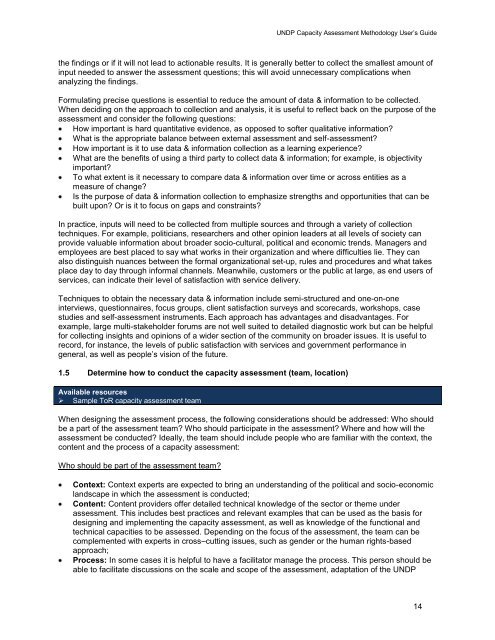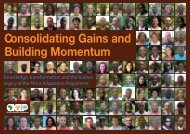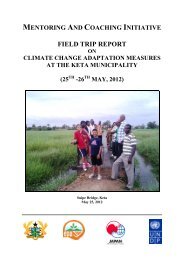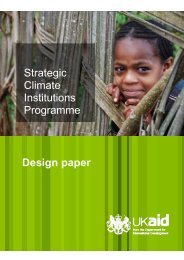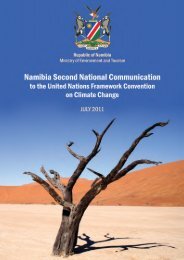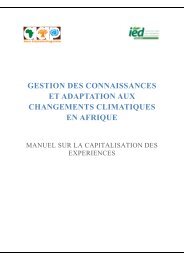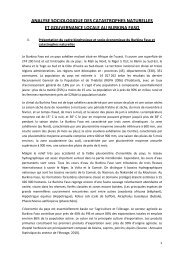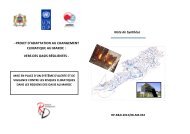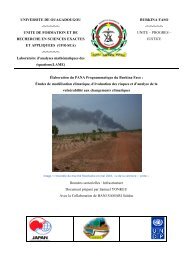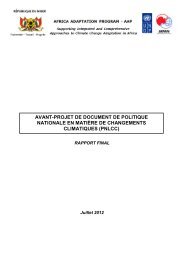UNDP Capacity Assessment Users Guide.pdf - Africa Adaptation ...
UNDP Capacity Assessment Users Guide.pdf - Africa Adaptation ...
UNDP Capacity Assessment Users Guide.pdf - Africa Adaptation ...
You also want an ePaper? Increase the reach of your titles
YUMPU automatically turns print PDFs into web optimized ePapers that Google loves.
<strong>UNDP</strong> <strong>Capacity</strong> <strong>Assessment</strong> Methodology User‘s <strong>Guide</strong>the findings or if it will not lead to actionable results. It is generally better to collect the smallest amount ofinput needed to answer the assessment questions; this will avoid unnecessary complications whenanalyzing the findings.Formulating precise questions is essential to reduce the amount of data & information to be collected.When deciding on the approach to collection and analysis, it is useful to reflect back on the purpose of theassessment and consider the following questions:How important is hard quantitative evidence, as opposed to softer qualitative information?What is the appropriate balance between external assessment and self-assessment?How important is it to use data & information collection as a learning experience?What are the benefits of using a third party to collect data & information; for example, is objectivityimportant?To what extent is it necessary to compare data & information over time or across entities as ameasure of change?Is the purpose of data & information collection to emphasize strengths and opportunities that can bebuilt upon? Or is it to focus on gaps and constraints?In practice, inputs will need to be collected from multiple sources and through a variety of collectiontechniques. For example, politicians, researchers and other opinion leaders at all levels of society canprovide valuable information about broader socio-cultural, political and economic trends. Managers andemployees are best placed to say what works in their organization and where difficulties lie. They canalso distinguish nuances between the formal organizational set-up, rules and procedures and what takesplace day to day through informal channels. Meanwhile, customers or the public at large, as end users ofservices, can indicate their level of satisfaction with service delivery.Techniques to obtain the necessary data & information include semi-structured and one-on-oneinterviews, questionnaires, focus groups, client satisfaction surveys and scorecards, workshops, casestudies and self-assessment instruments. Each approach has advantages and disadvantages. Forexample, large multi-stakeholder forums are not well suited to detailed diagnostic work but can be helpfulfor collecting insights and opinions of a wider section of the community on broader issues. It is useful torecord, for instance, the levels of public satisfaction with services and government performance ingeneral, as well as people‘s vision of the future.1.5 Determine how to conduct the capacity assessment (team, location)Available resources‣ Sample ToR capacity assessment teamWhen designing the assessment process, the following considerations should be addressed: Who shouldbe a part of the assessment team? Who should participate in the assessment? Where and how will theassessment be conducted? Ideally, the team should include people who are familiar with the context, thecontent and the process of a capacity assessment:Who should be part of the assessment team?Context: Context experts are expected to bring an understanding of the political and socio-economiclandscape in which the assessment is conducted;Content: Content providers offer detailed technical knowledge of the sector or theme underassessment. This includes best practices and relevant examples that can be used as the basis fordesigning and implementing the capacity assessment, as well as knowledge of the functional andtechnical capacities to be assessed. Depending on the focus of the assessment, the team can becomplemented with experts in cross–cutting issues, such as gender or the human rights-basedapproach;Process: In some cases it is helpful to have a facilitator manage the process. This person should beable to facilitate discussions on the scale and scope of the assessment, adaptation of the <strong>UNDP</strong>14


